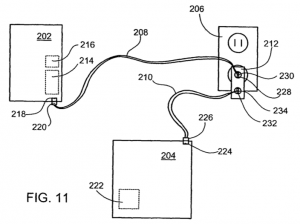Apple’s “Power Adapters for Powering and/or Charging Peripheral Devices” Patent Application: Rewind
An article entitled “Light Peak power patent” came out the other day.
It seemed a bit curious since optical fiber technology does not transmit power.
A quick search of patent databases would find a published (2010/0277007 A1) US patent application fitting the criteria presented in the above article. So what did Apple disclose in the above patent application?
A problem in the art is generally presented in Figure 1, and is discussed in The Background. Paragraphs [0003] – [0005] discuss a peripheral device 12 connected to a dedicated power cable 24, which in turn is connected to power adapter 28. Data is then transmitted between the peripheral device and host device 14 using data transmission line 16. Thus there are separate data and power cables. In paragraph [0006] it is stated that it would be desirable to reduce the number of connections and cables.
While there are many different embodiments presented with each having its own set of alternatives, Fig. 5, 6a, 6b and 11 will be considered here to get a sense of the disclosure. Fig. 5 presents a “bottom view” of power adapter 80. In this example data port 86 corresponds to a 6 wire Firewire port, implying the Firewire cable can be used for charging. In Fig. 6a and 6b the data transmission line 128 is alternatively connected to the power adapter 130 (Fig. 6a) and a data port 142 of host device 124 (Fig.6b). Thus, the same cable can be used for charging and data transfer. Finally, Fig. 11 presents an example where both a host device 204 and a peripheral device 202 are each connected to power adapter 212 by way of data transmission lines 210 and 208, respectively. While hinted at in other embodiments this example directly illustrates a host device (computer) receiving power through a data transmission line. 
In the end the disclosure teaches, at least, a single cable to carry power and data, with that cable being connected to a power adapter. Methods how this configuration might be implemented are also taught. One side might argue the disclosure teaches away from the use of an optical system as it can not carry power, while another side might argue an optical fiber in the data transmission line would be both known in the art and part of a composite system to carry data and power. In the end, the actual “patented” material will be defined by the prosecuted claims when they issue.


